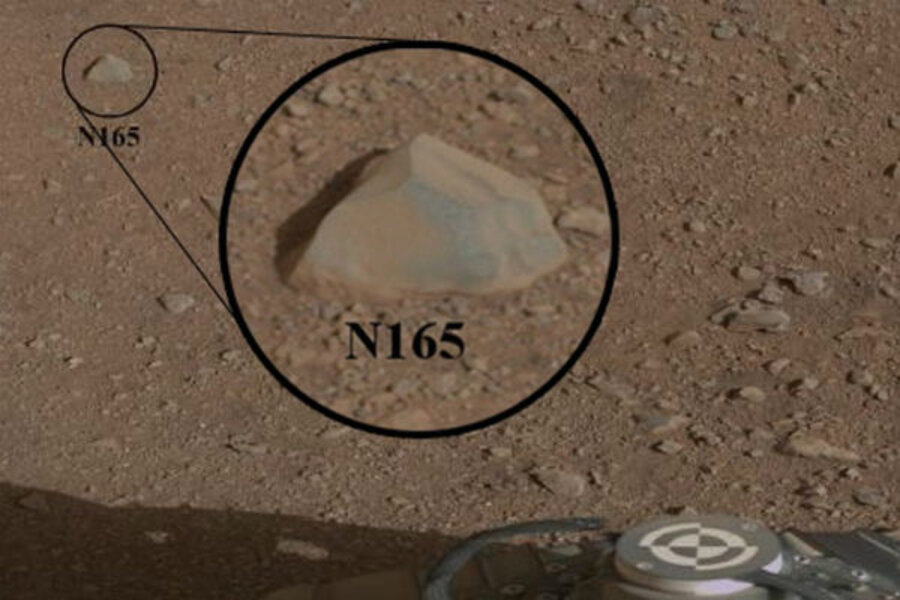Mars rover Curiosity zaps ‘Coronation’ rock with rapid-fire laser
Loading...
NASA's Mars rover Curiosity has zapped its first rock in what scientists elatedly declare a successful test of ChemCam, a laser-and-telescope combo designed to uncover the chemical composition of rocks on the Red Planet.
The instrument is set to play a key role in helping scientists fill in Curiosity's rock-hunting agenda over the next two years.
"After eight years building the instrument, it's payoff time!" said Roger Wiens, a physicist at the Los Alamos National Laboratory in Los Alamos, N.M., and the instrument's lead scientist, in a statement.
The rover's broad mission is to search for clues that might show whether Gale Crater and its three-mile-high summit, Mt. Sharp, hosted an environment hospitable for life some 3 billion to 4 billion years ago. Those clues, if they exist, hide in the chemical make-up of the rocks and soils at Curiosity's new home – especially rocks in the layered foothills of Mt. Sharp, the rover's ultimate destination.
ChemCam's ability to sample rocks from a distance of up to 23 feet will help researchers decide which rocks they want Curiosity to drive up to and analyze in more detail.
For Sunday's test, researchers aimed ChemCam at a rock roughly 3 inches across and located about 9 feet from the rover. The team initially tagged the rock with the prosaic label N165. But researchers finally settled on a name for it: Coronation.
Curiosity tickled Coronation with 30 laser pulses during a 10-second test – each pulse lasting for about 5 billionths of a second and depositing more than a megawatt of power on a spot the size of a pinhead.
From ChemCam's vantage point some 7 feet above the surface atop Curiosity's mast, the rapid-fire pulses generated what looked like a series of sparks at the rock. Each spark, in fact, was a tiny burst of hot, ionized gas known as a plasma. The telescope associated with the laser captured that light, sending it through fiber-optic lines to spectrometers inside Curiosity's body. The spectrometers hunted for the fingerprints of chemical elements encoded in the plasma's light.
The science team is still analyzing the results. But "we got a great spectrum of Coronation – lots of signal," Dr. Wiens said. "Our team is both thrilled and working hard, looking at the results."
Indeed, in some important respects, ChemCam is performing better on Mars than it did in tests on Earth, added Sylvestre Maurice, with the Institut de Recherche en Astrophysique et Planetologie in Toulouse, France, and the instrument's deputy lead scientist.
It's delivering more usable data, compared with potentially confounding background "noise," on Mars that it did on Earth.
The results are "so rich, we can expect great science from investigating what might be thousands of targets" over the next two years, Dr. Maurice said in a statement.
Indeed, researchers have noted that the instrument is primed for taking as many as 14,000 samples over the course of Curiosity's initial two years on Mars. ChemCam is designed to analyze spectra at 6,144 individual wavelengths that range from infrared light through ultraviolet light.
In addition to teasing the rock's chemical composition from the Coronation's spectra, scientists will be looking for changes in composition with each pulse. They already had thought of using the laser as a high-tech whisk boom, clearing away loose material on a rock's surface to get at the rock itself. But the team also is interested in analyzing the loose surface material itself.
During a briefing on Aug. 17, Dr. Wiens noted that by analyzing such material, researchers can build a picture of the weathering processes affecting a rock over the long period of time it has been exposed on the surface.
More details from the test are likely to emerge Tuesday afternoon during the mission's next scheduled briefing.






